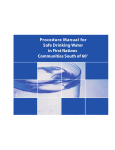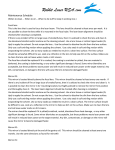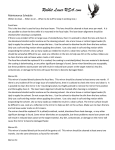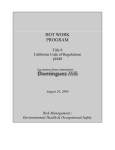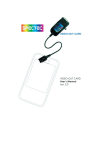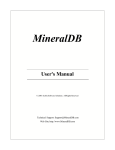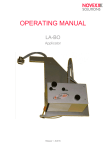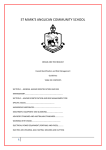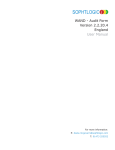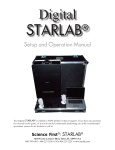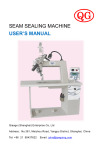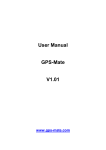Download Hot Work Program - California State University, Bakersfield
Transcript
WELDING, CUTTING, AND HOT WORK OPERATIONS PROGRAM CALIFORNIA STATE UNIVERSITY, BAKERSFIELD REVISION DATE: 2/15/2013 TABLE OF CONTENTS 1.0 PURPOSE Welding and hot work presents a significant opportunity for fire and injury. The hot work permit process is established to prevent ignition of combustible and flammable materials from occurring. Hot work permit procedures are utilized in any activity that results in the release of sparks, fire, molten slag, or hot material, which has the potential to cause fires or explosions. This program defines responsibilities and requires the use of a hot work permit in non-approved areas. This applies but is not limited to open flame, welding, burning, grinding; use of non-intrinsically safe electrical tools and instruments; work on electrical circuits; or use of spark producing devices. This also applies to work on portable and mobile containers, which contain or have contained flammable or combustible materials. The hot work program applies to all departments and vendors/contractors who perform welding and cutting on campus. However, approved welding/cutting areas are exempt from the hot work permit process. Hot work permits can be obtained from the Office of Safety and Risk Management (S&RM) or Facilities Management Trades Supervisor. 2.0 AUTHORITY Title 8, CCR, §4850 – 4853 Electric Welding, Cutting and Heating Title 8, CCR, §1743 Oxygen, Acetylene, and Fuel Gas Title 8, CCR, §4821 Gas Systems for Welding and Cutting Title 8, CCR, §1536 Ventilation Requirements for Welding, Brazing, and Cutting Title 8, CCR, §5150 Ventilation and Personal Protective Equipment Requirements for Welding, Brazing and Cutting Title 8, CCR, §5155 Airborne Contaminants Title 8, CCR, § 4846 – 4848 Fire Prevention in Welding and Cutting Operations NFPA 51, Standard for the Design and Installation of Oxygen Fuel Gas Systems for Welding, Cutting and Allied Processes NFPA 51B, Standard for Fire Prevention in Use of Cutting and Welding Processes ANSI Z491, American National Standard Safety in Welding and Cutting API 2201, Procedures for Welding or Hot Tapping on Equipment Containing Flammables 3.0 POLICY It is the policy of California State University, Bakersfield that all employees operate in a safe and healthful manner adhering to the safety standards established by Cal/OSHA and the University's internal hot work procedures. All employee(s) or contractors engaged in work defined under this program will adhere to all provisions as established by the Office of Safety and Risk Management and this program. 4.0 DEFINITIONS HOT WORK Work that may generate heat, flames, or sparks; this may include, but is not limited to, welding, torch cutting, brazing, soldering, and grinding. Welding/Hot Works Procedures Any activity which results in sparks fire, molten slag, or hot material which has the potential to cause fires or explosions. Special Hazard Occupancies Any area containing Flammable Liquids, Dust Accumulation, Gases, Plastics, Rubber and Paper Products. 6.0 RESPONSIBILITIES 6.1 Safety and Risk Management: Periodically reviews these procedures for consistency with regulatory changes and recommends appropriate procedure amendments. At the department’s request RM/EHOS can provide an independent assessment of the work area and sign the permit for and permits involving welding, burning and grinding on any in-service piping and during hot work inside a confined space. 6.2 Facilities Management: Insures that all staff comply with the provisions of the program. Insures that annual training is conducted for all staff responsible for hot work procedures. 6.3 Facilities Planning and Construction: Insures that independent contractors are instructed to follow the provisions of this program during the performance of hot work procedures. 6.4 Employee: Read, understand and follow the conditions listed on the Hot Work Permit. Advise other workers of any special precautions or conditions pertaining to the job. Survey the work area to confirm safe work conditions. Know the location of the nearest telephone, fire alarm, emergency communication system, fire extinguisher, safety shower, first aid kit, etc., before starting work, and know how to use them. Confine all sparks and slag as close to the work area as possible. Inspect the work area and adjacent area for a distance at least 35’ around the hot work site, including the other side of any wall or barrier, to which sparks or heat might spread. Ensure the equipment and area has been properly prepared and is ready for the safe performance of the work. Receive a Hot Work Permit checklist prior to performing work. Ensure that the hard copy of the permit has been posted at the work location. 7.0 PROCEDURES 7.1 Welding, Cutting or Hot Work Permit: A written permit (see Appendix A) must be obtained from one of the following individuals prior to initiating any welding, cutting or hot work operation. (a) RM/EHS staff member. (b) Facilities Services Director (c) Facilities Services Manager. (d) Facilities Services Shop Supervisor. Exceptions to written permit requirement The following activities do not require a written permit. Welding, cutting, and hot work operations carried out in pre- established maintenance shop areas or academic department shop areas. Soldering operations carried out by employees performing plumbing maintenance activities outside of buildings. The individual issuing the permit must personally examine the location where the work is to be done and insure that all safety precautions have been met. Specific fire requirements are outlined on the Hot Work Permit. The permit will be issued to one person responsible for the work to be accomplished. The Hot Work Permit must be displayed at the job site, preferably attached to or near the welding or cutting equipment. Contractor permits may be issued for the duration of the contract or specific job. Periodic inspections may be made. This requirement applies to all contract work, no matter what department the work is being performed in. After completion of the job, a copy of the Hot Work Permit must be sent to the campus RM/EHS Office for retention. General Safety Rules for Welding, Cutting and Hot Work No device or attachment facilitating or permitting mixture of air or oxygen with combustible gases prior to consumption, except at the burner or in a standard torch or blowpipe, shall be allowed unless approved for that purpose. The user shall not transfer gases from one cylinder to another in order to mix gases in a cylinder. Oxygen shall never be used from cylinders through torches or other devices equipped with shutoff valves, without reducing the pressure through a suitable regulator attached to the cylinder valve or manifold. Acetylene gas shall not be brought into contact with unalloyed copper except in blowpipe or torch. Fuel gas shall never be used from cylinders through torches or other devices equipped with shutoff valves, without reducing the pressure through a suitable regulator attached to the cylinder valve or manifold. Exception: low pressure containers of propane or MAPP gas. Cylinders, valve regulators, hose and other apparatus and fittings containing or using oxygen shall be kept free from oil and grease. Oxygen cylinders and apparatus and fittings shall not be handled with oily hands, gloves or greasy materials. When moving compressed gas cylinders by crane or hoist, suitable cradles shall be used in order to reduce the possibility of dropping. Ordinary rope slings or electro-magnets shall not be used. Oxygen and fuel gas cylinders shall be placed far enough away from the welding position so they will not be unduly heated by radiant heated materials, by sparks or slag, or by misdirection of the torch flame. No gas welding or cutting shall be done in or near rooms or locations where flammable liquids/vapors, lint, dust or loose combustible stock are so located or arranged that sparks or hot metal from the welding or cutting operations may cause ignition or explosion of such materials. When such welding or cutting must be done above or within ten feet of combustible construction or material, or above a place where workers are employed, or where persons are likely to pass, noncombustible shields shall be interposed to protect such materials and persons from sparks and hot metal or oxide. One or more portable fire extinguishers of a suitable type shall be staged near/at the location where welding or cutting is being done. When welding or cutting is done above or within ten feet of combustible construction or material, a fire watch shall be prepared to use fire-extinguishing equipment, if needed. A fire watch shall be maintained for at least one half hour (30 minutes) after completion of cutting or welding operations to detect and extinguish possible smoldering fires. This time may be increased in extremely flammable areas or wood frame buildings. 25. Welding or Cutting is NOT permitted when: a. Performed in areas not authorized by management. b. Potentially explosive atmospheres (i.e. flammable atmospheres) exists. c. In storage areas of exposed, readily ignitable materials. d. Where dust accumulation is 1/16 of an inch within 35 feet of the area. All dust accumulation shall be removed before welding/hot work is started. Inspection of non-approved welding areas The individual issuing the permit must personally examine the location where the work is to be done and insure that all safety precautions have been met. The permit will be issued to one person responsible for the work to be accomplished. The Hot Work Permit must be displayed at the job site, preferably attached to or near the welding or cutting equipment. Precautions for non-approved areas include, but are not limited to: • Ensuring adequate ventilation is provided; • Removing combustibles from common surfaces when welding on metal walls, partitions, or ceilings is to be completed or providing fire-resistant shields or guards; • Pay attention to welding or cutting pipes in contact with walls made with combustible materials; • Ducts, conveyor systems, and piping that might carry sparks to distant combustibles shall be protected, shut down or closed off; • Portable welding curtains or shields installed to protect other workers in the area by containing sparks and slag; • Post a fire watch in areas where combustibles cannot be safely segregated from work or where sparks may impact lower levels in cases of elevated work. A second fire watch may be required on the back side of wall were welding is taking place. Where practical all combustibles will be relocated at least 35 feet from the work site. • Where relocation is impractical, combustibles must be protected with flameproof covers, shielded with metal, guards, curtains or wet down to help prevent ignition of material. • Ducts, conveyor systems, and augers that might carry sparks to distant combustibles must be protected or shut down. • Where cutting welding is done near walls, partitions, ceilings, a roof of combustible construction, fire- resistant shield or guards will b e provided to prevent ignition • If welding is to be done on a metal wall, partitions, ceiling, or proof, precautions must be taken to prevent ignition of combustibles on the other side, due to conductions or radiation of heat. • Where combustibles cannot be relocated on the opposite side of work, a fire watch person will be provided on the opposite side the work. • Welding will not be attempted on a metal partition, wall, ceiling, or roof having a covering or on walls having combustible sandwich panel construction. • Cutting or welding on pipes or other metal in contact with combustible walls, partitions, ceiling, or roofs will not be undertaken if the work is close enough to cause ignition by combustion. • In areas where there is dust accumulation of greater that 1/16 inch within 35 feet of the area where welding/hot works will be conducted, all dust accumulation will be cleaned up following the housekeeping program of the facility before welding/hot works are permitted. • Suitable fire extinguishers must be provided and maintained ready for instant use. • A fire watch person will provided during and for two hours past the completion of the welding project. • A cutting/welding permit will be issued on all welding or cutting outside of designated welding areas. Cutting or welding will not be permitted in the following situations: • In areas not authorized by management • In sprinklered building while such protection is impaired. • In the presence of potentially explosive atmospheres. • In areas near the storage of large quantities of exposed, ready readily ignitable materials. Standard Operating Procedures Welding Standard Operating Procedures 1. Valves, regulators, hoses, fittings, gages, electric leads, voltage setting, tips, torches, etc. should be checked. 2. Ensure fittings are tight. 3. Inspect hoses for cuts and frayed areas. 4. Repair or replace any defective equipment before using. 5. Set gauges to desired PSI. 6. Ensure that the following PPE is available and are in good condition: a. Respirator – must be worn at all times, inspected before and after use, and in good condition (replace any parts as necessary). b. Gloves – worn on both hands. c. Face shield or welding helmet with required tint protection. d. Safety glasses with side shields e. Work boots f. Earplugs – worn especially during plasma cutting and grinding. g. Leather apron 7. Fire extinguisher charged and ready. 8. Locate and set up welding screens to protect employees, but DO NOT block your EXIT. 9. Ensure that adequate ventilation and lighting are in place. 10. No eating, drinking, or storage of food in the welding area. 11. Follow the user’s manual carefully. 12. Use a spark lighter to obtain a flame. DO NOT use matches since the first puff of flame can burn your hand. 13. Be aware of possible backfire (torch sputters or goes out with a loud pop, this can be caused by a clogged tip) and flashback (torch begins making a loud squealing noise and becomes very hot or emits dense smoke caused by the flame receding into the torch body or the hoses, this is a very dangerous condition), and the procedures to follow if this occurs (i.e. shut down the entire rig an allow to clean, inspect all parts, clean or repair parts as necessary, etc.). 14. Weld on firebrick only, but not directly on the firebrick. Suspend the work between firebricks. 15. Do not weld or cut galvanized steel or steel plated with zinc, cadmium, or lead since they emit toxic gases. 16. Never use oil, grease or solvents near the welding rig since they react explosively with oxygen. 17. DO NOT use the acetylene gas at pressures greater than 15 PSI since higher pressures can spontaneously explode this gas. 18. Open the oxygen cylinder valve slowly because a rush of high-pressure gas can damage the rest of the rig. 19. Open the acetylene cylinder valve ½ turn and leave the valve wrench in place so the cylinder can be shut off fast in an emergency. 20. If you sense a distinctive nauseating odor of acetylene, shut down the rig. SOP- Electric Welding (Title 8 CCR - Article 90. Electric Welding, Cutting and Heating (Sections 4850 - 4853) • Perform Safety Check on all equipment • Ensure fire extinguisher is charged and available • Ensure electrical cord, electrode holder and cables are free from defects (no cable splices are allowed within 10 feet of the electrode holder) • Ensure PPE (welding hood, gloves, rubber boots/soled shoes, and aprons) are available and have no defects. • Ensure the welding unit is properly grounded • All defective equipment must be repaired or replaced before use • Remove flammables and combustibles • No welding is permitted on or near containers of flammable material, combustible material or unprotected flammable structures • Place welding screen or suitable barricade around work area to provide a fire safety zone and prevent injuries to passersby (do not block emergency exits or restrict ventilation). • Ensure adequate ventilation and lighting • Execute Hot Work Permit procedures • Set Voltage Regulator no higher than the following for: o Manual Alternating Current Welders- 80 volts o Automatic Alternating Current Welders – 100 volts o Manual or automatic Direct Current Welders – 100 volts • Uncoil and spread out welding cable • To avoid overheating, ensure proper contact of work leads and connections, remove any metal fragments from magnetic work clamps (to avoid electric shock do not warp welding cables around a body part and avoid welding in wet conditions) • Fire watch for one hour after welding and until all welds have cooled • Perform final watch and terminate permit. SOP- Gas Welding 1910.253 - Oxygen-fuel gas welding and cutting 1926.350 - Gas welding and cutting. • Perform Safety Check on all equipment • Ensure tanks have gas and fitting are tight • Ensure fire extinguishers is charged and available • Inspect hoses for defects • Ensure PPE (welding hood, gloves, rubber boots/soled shoes and aprons) are available and have no defects • All defective equipment must be repaired or replaced before use! • Remove flammables and combustibles • No welding is permitted on or near containers of flammable material, combustible material or unprotected flammable structures • Place welding screen or suitable barricade around work area to provide a fire safety zone and prevent injuries to passersby (do not block emergency exits or restrict ventilation). • Use an authorized Air Filtering Respirator, if required • Ensure adequate ventilation and lighting • Execute Hot Work Permit Procedures • Open valves on oxygen and gas tanks to desired flow • Shut tank valves and relieve hose pressure. Store Hoses. • Fire watch for one hour after welding and until all welds have cooled. • Perform final fire watch and terminate permit Compressed Gas Care, Transporting, Moving and Storage Article 32 - §1740. Storage and Use of Cylinders / §1743. General Precautions. • Valve caps on cylinders must be in place and secured. Valve caps must not be used for lifting. Do not pry cylinder caps while frozen. Loosen caps with warm water. • Cylinders must be transported on a secured cradle only, and by tilting or rolling them. • Cylinders must be moved by tilting and rolling them on their bottom edges. Avoid dropping cylinders or striking other cylinders. • Cylinders transported by powered vehicles must be secured in a vertical position • Regulators must be removed and caps put in place prior to moving cylinders, unless cylinders are secured on a special carrier • Proper steadying devices must be used to keep cylinders from falling over while in use • Cylinder calves must be closed when cylinders are empty or when cylinders are moved • Oxygen cylinders must be stored separated from fuel gas cylinders or combustible materials a minimum distance of 20 feet or by a five foot high noncombustible barrier with a fire-resistance rating of onehalf hour. • Cylinders stored inside building must be stored 20 feet from combustible materials where they were well protected, well ventilated, and dry. Cylinders must not be stored near elevators, stairs or gangways. Assigned storage locations must prevent cylinders from being knocked over or damaged. • Cylinders must be kept away from welding or cutting operations to prevent sparks, hot slag, or flame from reaching them. Fire resistant shields must be used when this impractical. • Cylinders must be placed away from electrical circuits. Do not strike electrodes against a cylinder to strike an arc. • Cylinders containing oxygen, acetylene or other fuel gas must not be used in confined spaces. • Cylinders must not be used as rollers or supports • Only the gas supplier is authorized to mix gases in a cylinder. Only the Supervisor is authorized to have cylinders refilled. • No damaged or defective cylinder may be used. Use of Fuel Gas - 1910.253 - Oxygen-fuel gas welding and cutting. • California State University-San Marcos employees will be instructed in the safe use of fuel gas. • Valves must be opened slightly and closed immediately before a regulator is connected to the cylinder. This is called “cracking” which clears the valve of dust and dirt. The employee must stand to the side of the outlet, not in front. Valves must be cracked away from welding work, sparks, flames or other sources of ignition. • Valves must be opened slowly to prevent damage to the regulator. Valves must not be opened more than 1 ½ turns. If wrench is required it must stay in position in case of emergency for a quick shut off. Manifold or coupled cylinders must have a wrench available for immediate use. Do not place objects on top of cylinders, or damage may occur to the safety device or interfere with the quick closing of the valve. • Cylinders must be closed and the gas released from the regulator before removing the regulator. If cylinders, valves, regulators, plug, or other safety devices are damaged, the must be tagged out of service and removed from the work area. Manifolds • Fuel gas and oxygen manifolds must bear the name of the substance they contain. • Fuel gas and oxygen manifolds must be placed in safe, well ventilated and accessible locations. • Hose connections must be made so that they cannot be interchanged between fuel gas and oxygen manifolds and supply header connections. Keep hose connections free of grease and oil, and do not use adapters to interchange hoses • Manifold and header hose connections must be capped when not in use. • Nothing may be placed on manifolds that will damage the manifold or interfere with the quick closing of the valves Hoses • Fuel gas hose and oxygen hose must be distinguishable from each other, and not be interchangeable. Contrast may be made by different colors or by surface characteristics distinguishable by the sense of touch • Employees will inspect all hoses in use at the beginning of each work shift. Defective hoses will b e tagged and removed from service • Hoses subjected to flashback, or which show severe wear or damage must be tested at twice that normal pressure from the hose, but not less than 300 p.s.i. if defective, hose must not be used. • Hose couplings must be disconnected by rotary motion only. • Hoses stored in boxes must be well ventilated. • Hoses, cables, and other equipment must be kept clear of passageways, ladders and stairs Torches • Torches must be inspected at the beginning of each working shift for leaving shutoff valves, hose coupling, and tip connections. Defective torches may not be used. • Clogged torch tip openings must be cleaned • Torches may be lit by friction lighters or other approved devices only Regulators and Gauges • Pressure and regulators and related gauges, must work properly while in use Oil and Grease Hazards • Oxygen cylinders and fittings must be kept away from oil or grease. Cylinders and fittings must be kept free from oil or greasy substances and may not be handled with oily hands or gloves. Oxygen must not be directed at oily surfaces, greasy clothes, or within a fuel oil or other storage tank or vessel. Fire Protection • Objects to be welded, cut or heated must be moved to a designated safe location. If the object cannot be easily moved all moveable fire hazards will be moved protected. • If the object to be welded, cut or heated cannot be moved and if all the fire sparks, and slag, and to protect the immovable fire hazards from them • Welding, cutting, or heating must not be performed in the presence of flammable paints, flammable compounds or heavy dust concentrations. • Fire extinguishers must be immediately available in the work area, free of obstruction, and maintained for instant use. • When normal fire prevention precautions are not sufficient for the welding, cutting, or heating operation supervisor will assign a fire watch. Sufficient amount of time msut be allowed after completion of work to ensure that the possibility of fire does not exist. The designated fire watch, must be trained in firefighting equipment. • Gas supplies must be shut off during lunch breaks, overnight, or during shift breaks. Hoses and torches must be removed from confined spaces. Training California State University- San Marcos employees required to become familiar with and understand the guidelines regarding welding and cutting operations. Designated welders and cutters must received annual training and must demonstrate their understanding of these guidelines to the supervisor. Training should include: 1. Review of requirements listed in TITLE 8 CCR Sections 4794-4799,and articles 82,83,87,88, & 90, also, OSHA 1910.252, 2. Use of Hot Work Permit System 3. Supervisor responsibilities 4. Fire watch responsibilities 5. Operator responsibilities 6. Contractors responsibilities 7. Documentation requirements 8. Respirator usage requirements 9. Fire Extinguisher training Upon completion of Welding and Cutting training California State University- San Marcos will certify in writing that each designate welder has received and understands training requirements. Certification must include employees name, name of the trainer, date of training, and subject of certification.














